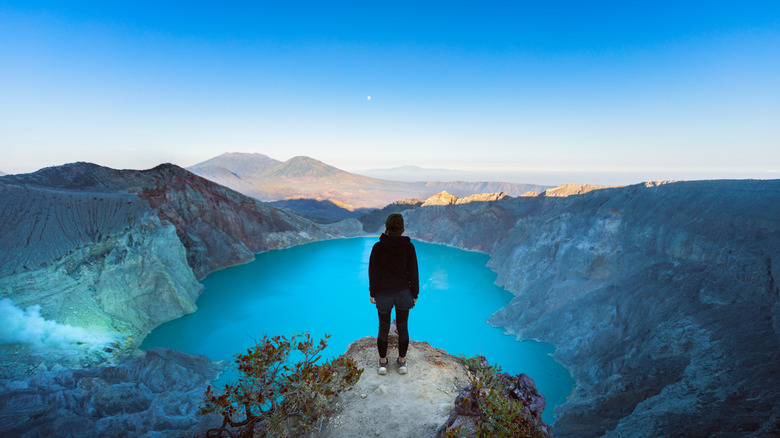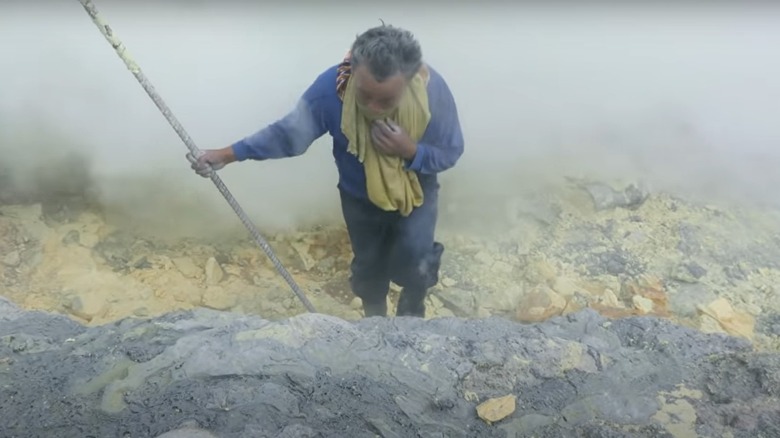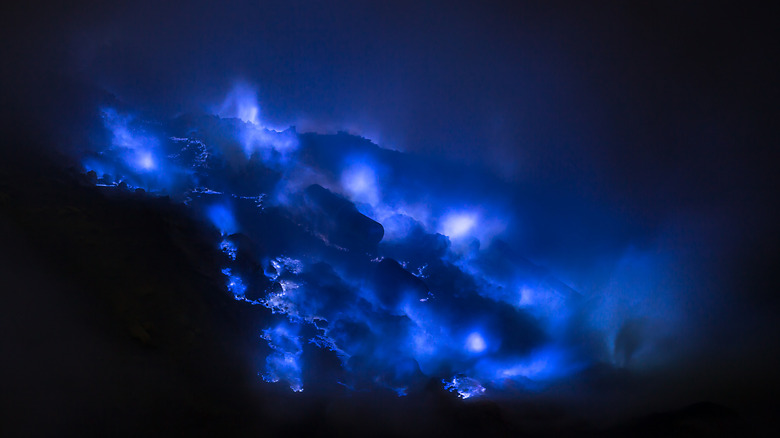The Dark Secret Hiding Within This Blue Lava Volcano
We may receive a commission on purchases made from links.
Does anyone remember that scene from the original "Robocop" where a dude gets smothered in "toxic waste" and instead of changing into a ninja turtle erupts into fleshy goo globs on the windshield of a speeding car? Right. Sorry to remind you if you think it's disgusting and not funny. Well, imagine there's this giant vat of electric blue lava that burns at 600 degrees Fahrenheit, spews noxious, sulfuric gas into the atmosphere, and is more acidic than battery acid, as Live Science says. What we're saying is: If you decide to pay this place a visit in Indonesia and don't keep an eye on your kids, don't blame us if one of them falls in and ends up like that guy from "Robocop."
All comedy aside, Kawah Ijen in East Java, Indonesia, isn't the most hospitable place on Earth. It's a stinky, open-air caldera full of steaming hot, liquid sulfur and carbon dioxide that continually vents into the air. It's also very pretty, which might explain why so many people visit every year. The Institute of Physics says that Kawah Ijen received almost 17,000 international travelers in 2017, and about 104,000 Indonesians. Some tourists wear gas masks, as The World Travel Guy shows. But the laborers who carry hundreds of pounds of sulfuric rock down the volcano every day in back-breaking conditions in full sight of those wealthy enough to pay a visit? They definitely don't have gas masks while earning $5 a day, per The Borgen Project.
A prime dark tourism spot
The Borgen Project says that Kawah Ijen was unknown until 2010 when the government started pushing for more tourism. Now, only a little more than a decade later, there's an entire "dark tourism" economy built around the site, as a YouTube documentary by Journeyman Pictures explores. Wealthy visitors can mingle with men risking their lives to haul sulfuric rock for pennies and peddle chunks to tourists as souvenirs. Sites like Viator and Trip Advisor offer tour packages from about $50 per person to $200 or more. Jet Set Together outlines travel itineraries to the volcano, while Something of Freedom — a tragically ironic title — outlines the costs of entering the site, which equal 100,000 rupiah on a weekday (about $6.65) and 150,000 on the weekend (about $10).
Such costs might not sound like a lot until you consider that the folks hauling baskets of bright yellow rocks on their shoulders in plain view earn about 15 cents per pound for horrific, life-threatening work conditions, per the Borgen Project. But for travelers who've spent thousands on airfare to Bali, driven a car to the north of the island, taken a 45-minute boat road to Java, booked a personal taxi to go one hour[ to the Kawah Ijen, and then embarked on a 3-hour, 40-minute roundtrip hike to the caldera (per All Trails) to take an Instagram selfie with an impoverished local who's suffering to make sure he doesn't starve, $10 is probably no biggie.
Digging for Devil's Gold
Taken as a natural phenomenon, Kawah Ijen really is quite stunning, especially at night. The volcano's sulfuric gases ignite when they reach the surface, which causes its unique blue flames, as Geology.com says. Per Live Science, 2,100-feet-deep magma funnels sulfuric gases to the surface, which condense into liquid if the temperature is low enough. That's when workers collect it in big chunks. The sulfur itself — called "Devil's Gold" by locals — is most commonly used to make sugar whiter, per the BBC.
Geology.com says that water from Kawah Ijen flows downstream to the Banyupahit River and makes the water so acidic it dissolves metals. Per Live Science, the pH level of the lava-like liquid in the caldera is 0.5, more acidic than battery acid. Very Well Health describes how such acid causes severe chemical burns on the skin, while Healthline says that inhaling its fumes causes respiratory problems. And indeed, the aforementioned Journeyman Pictures YouTube documentary says that workers at Kawah Ijen don't typically make it past 50 years old.
And if you're thinking that increased tourism to the area increases the standards of living for all locals: no. The Borgen Project explains that workers reap none of the benefits. Their wages have stayed the same for decades. One miner in the Journeyman Pictures documentary talks about how he's stuck without cars, connections, and business partners. And so the rest of us are also stuck between natural beauty and human exploitation.


